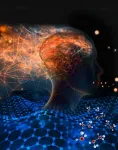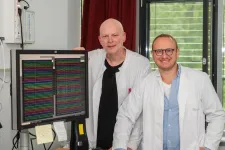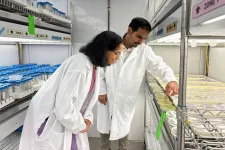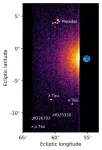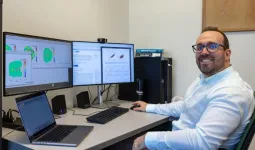(Press-News.org) UNIVERSITY PARK, Pa. — A recently developed electronic tongue is capable of identifying differences in similar liquids, such as milk with varying water content; diverse products, including soda types and coffee blends; signs of spoilage in fruit juices; and instances of food safety concerns. The team, led by researchers at Penn State, also found that results were even more accurate when artificial intelligence (AI) used its own assessment parameters to interpret the data generated by the electronic tongue.
The researchers published their results today (Oct. 9) in Nature.
According to the researchers, the electronic tongue can be useful for food safety and production, as well as for medical diagnostics. The sensor and its AI can broadly detect and classify various substances while collectively assessing their respective quality, authenticity and freshness. This assessment has also provided the researchers with a view into how AI makes decisions, which could lead to better AI development and applications, they said.
“We’re trying to make an artificial tongue, but the process of how we experience different foods involves more than just the tongue,” said corresponding author Saptarshi Das, Ackley Professor of Engineering and professor of engineering science and mechanics. “We have the tongue itself, consisting of taste receptors that interact with food species and send their information to the gustatory cortex — a biological neural network.”
The gustatory cortex is the region of the brain that perceives and interprets various tastes beyond what can be sensed by taste receptors, which primarily categorize foods via the five broad categories of sweet, sour, bitter, salty and savory. As the brain learns the nuances of the tastes, it can better differentiate the subtlety of flavors. To artificially imitate the gustatory cortex, the researchers developed a neural network, which is a machine learning algorithm that mimics the human brain in assessing and understanding data.
“Previously, we investigated how the brain reacts to different tastes and mimicked this process by integrating different 2D materials to develop a kind of blueprint as to how AI can process information more like a human being,” said co-author Harikrishnan Ravichandran, a doctoral student in engineering science and mechanics advised by Das. “Now, in this work, we’re considering several chemicals to see if the sensors can accurately detect them, and furthermore, whether they can detect minute differences between similar foods and discern instances of food safety concerns.”
The tongue comprises a graphene-based ion-sensitive field-effect transistor, or a conductive device that can detect chemical ions, linked to an artificial neural network, trained on various datasets. Critically, Das noted, the sensors are non-functionalized, meaning that one sensor can detect different types of chemicals, rather than having a specific sensor dedicated to each potential chemical. The researchers provided the neural network with 20 specific parameters to assess, all of which are related to how a sample liquid interacts with the sensor’s electrical properties. Based on these researcher-specified parameters, the AI could accurately detect samples — including watered-down milks, different types of sodas, blends of coffee and multiple fruit juices at several levels of freshness — and report on their content with greater than 80% accuracy in about a minute.
“After achieving a reasonable accuracy with human-selected parameters, we decided to let the neural network define its own figures of merit by providing it with the raw sensor data. We found that the neural network reached a near ideal inference accuracy of more than 95% when utilizing the machine-derived figures of merit rather than the ones provided by humans,” said co-author Andrew Pannone, a doctoral student in engineering science and mechanics advised by Das. “So, we used a method called Shapley additive explanations, which allows us to ask the neural network what it was thinking after it makes a decision.”
This approach uses game theory, a decision-making process that considers the choices of others to predict the outcome of a single participant, to assign values to the data under consideration. With these explanations, the researchers could reverse engineer an understanding of how the neural network weighed various components of the sample to make a final determination — giving the team a glimpse into the neural network’s decision-making process, which has remained largely opaque in the field of AI, according to the researchers. They found that, instead of simply assessing individual human-assigned parameters, the neural network considered the data it determined were most important together, with the Shapley additive explanations revealing how important the neural network considered each input data.
The researchers explained that this assessment could be compared to two people drinking milk. They can both identify that it is milk, but one person may think it is skim that has gone off while the other thinks it is 2% that is still fresh. The nuances of why are not easily explained even by the individual making the assessment.
“We found that the network looked at more subtle characteristics in the data — things we, as humans, struggle to define properly,” Das said. “And because the neural network considers the sensor characteristics holistically, it mitigates variations that might occur day-to-day. In terms of the milk, the neural network can determine the varying water content of the milk and, in that context, determine if any indicators of degradation are meaningful enough to be considered a food safety issue.”
According to Das, the tongue’s capabilities are limited only by the data on which it is trained, meaning that while the focus of this study was on food assessment, it could be applied to medical diagnostics, too. And while sensitivity is important no matter where the sensor is applied, their sensors’ robustness provides a path forward for broad deployment in different industries, the researchers said.
Das explained that the sensors don’t need to be precisely identical because machine learning algorithms can look at all information together and still produce the right answer. This makes for a more practical — and less expensive — manufacturing process.
“We figured out that we can live with imperfection,” Das said. “And that’s what nature is — it’s full of imperfections, but it can still make robust decisions, just like our electronic tongue.”
Das is also affiliated with the Materials Research Institute and the Departments of Electrical Engineering and of Materials Science and Engineering. Other contributors from the Penn State Department of Engineering Science and Mechanics include Aditya Raj, a research technologist at the time of the research; Sarbashis Das, a graduate student at the time of research who earned his doctorate in electrical engineering in May; Ziheng Chen, a graduate student in engineering science and mechanics; and Collin A. Price, a graduate student who earned his bachelor of science in engineering science and mechanics in May. Mahmooda Sultana, with the NASA Goddard Space Flight Center, also contributed.
A Space Technology Graduate Research Opportunities grant from NASA supported this work.
END
A matter of taste: Electronic tongue reveals AI inner thoughts
2024-10-09
ELSE PRESS RELEASES FROM THIS DATE:
Another step towards decoding smell
2024-10-09
We often only realize how important our sense of smell is when it is no longer there: food hardly tastes good, or we no longer react to dangers such as the smell of smoke. Researchers at the University Hospital Bonn (UKB), the University of Bonn and the University of Aachen have investigated the neuronal mechanisms of human odor perception for the first time. Individual nerve cells in the brain recognize odors and react specifically to the smell, the image and the written word of an object, for example a banana. The results of this study close a long-standing knowledge gap between animal and human odor research and have now been published in the renowned ...
Plant Science Research collaboration will explore key mosses critical to storing carbon
2024-10-09
ST. LOUIS, MO, October 9, 2024 - Plant scientists at the Donald Danforth Plant Science Center and the HudsonAlpha Institute for Biotechnology have been awarded a four-year National Science Foundation (NSF) Enabling Discovery through GEnomics (EDGE) grant to advance their understanding of sphagnum moss, a crucial component of peatlands and a vital player in global ecosystems. The collaborative research team will develop genetic and genomic resources to study sphagnum's life cycle, growth, and adaptation to various environmental conditions.
Sphagnum ...
Researchers examine the persistence of invisible plastic pollution
2024-10-09
Plastic pollution – tiny bits of plastic, smaller than a grain of sand – is everywhere, a fact of life that applies even to newborn rodents, according to a Rutgers Health study published in the journal Science of the Total Environment.
Researchers have long understood that micro- and nanoplastic particles (MNPs), which enter the environment through oxidation and natural degradation of consumer products, are easily deposited in the human body through inhalation, absorption and diet.
Experts also understand that these pollutants can cross the placental barrier and deposit ...
Coffee during pregnancy safe for baby’s brain development
2024-10-09
A University of Queensland-led study has failed to find any strong links between drinking coffee during pregnancy and neurodevelopmental difficulties in children, but researchers are advising expectant mothers to continue following medical guidelines on caffeine consumption.
Dr Gunn-Helen Moen and PhD student Shannon D’Urso from UQ’s Institute for Molecular Bioscience (IMB) led an in-depth genetic analysis of data from tens of thousands of families in Norway.
“Scandinavians are some of the biggest coffee consumers in the world, drinking at least 4 cups a day, with little stigma about drinking coffee during pregnancy,” ...
SwRI-led instrument aboard Jupiter-bound spacecraft nails in-flight test
2024-10-09
SAN ANTONIO — October 9, 2024 —As European Space Agency (ESA)’s Jupiter Icy Moons Explorer (Juice) spacecraft hurtled past the Moon and Earth in mid-August to provide its first gravity assist maneuver to the Jovian system, the Southwest Research Institute-led Ultraviolet Spectrograph (UVS) instrument imaged the UV emissions radiating from the Earth and Moon.
It was a successful test of one of three science instrument projects comprising NASA’s contribution to ESA’s Juice mission. The UVS data collected were then analyzed and found to be consistent with expectations for the Moon and the Earth. This confirmation that the instrument works ...
New AI models of plasma heating lead to important corrections in computer code used for fusion research
2024-10-09
New artificial intelligence (AI) models for plasma heating can do more than was previously thought possible, not only increasing the prediction speed 10 million times while preserving accuracy, but also correctly predicting plasma heating in cases where the original numerical code failed. The models will be presented on October 11 at the 66th Annual Meeting of the American Physical Society Division of Plasma Physics in Atlanta.
“With our intelligence, we can train the AI to go even beyond the limitations ...
Study: Rise in English learner students in “new destination” states helps, does not hurt, academic outcomes for existing students
2024-10-09
Washington, October 9, 2024—English learner (EL) students represent the fastest growing student group in the United States over the past two decades, with numbers of EL students in public schools soaring in “new destination” states across the South and Midwest. Some commentators have expressed concerns about the possible adverse effect of immigrant students on current students if they require additional resources that are diverted from their peers.
However, a new study finds significant positive spillover effects ...
LANDFEED project kicks off: Transforming agro-food waste into bio-based fertilizers to support Europe’s circular economy
2024-10-09
The LANDFEED project, co-funded by the European Union, held its official kick-off meeting on 12-13 September in Bilbao, Spain. Coordinated by Miriam Pinto from NEIKER, LANDFEED brings together experts across Europe to implement sustainable, circular solutions to Europe’s waste challenges, helping to increase the continent's self-sufficiency in agricultural resources while reducing environmental impact.
LANDFEED will focus on converting under-utilised waste from the agri-food industry, forestry, urban centres, and the natural environment into ...
Mcity opens for remote testing of autonomous vehicle technologies, calls for federal standards
2024-10-09
Images/Videos
As Mcity begins welcoming researchers in autonomous and connected vehicle technologies from around the U.S. to be remote users of its physical and virtual testing environment, its leadership is calling for federal standards for safety testing, arguing that the lack of clear goalposts is hampering development.
The opening also coincides with a new industry partnership project announced at the NVIDIA AI Summit.
Following two years of upgrades, the University of Michigan's hub for autonomous testing has officially kicked ...
Adding vagus nerve stimulation to training sessions may boost how well sounds are perceived
2024-10-09
Just as a musician can train to more sharply distinguish subtle differences in pitch, mammals can improve their ability to interpret hearing, vision, and other senses with practice. This process, which is called perceptual learning, may be enhanced by activating a major nerve that connects the brain to nearly every organ in the body, a new study in mice shows.
Led by researchers at NYU Langone Health, the investigation centers on the vagus nerve, which carries signals between the brain and the heart, digestive system, and other organs. Experts have long explored targeting this nerve with ...
